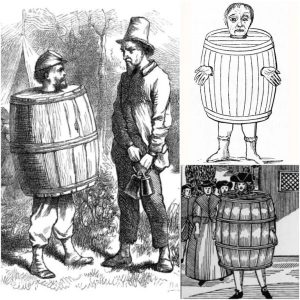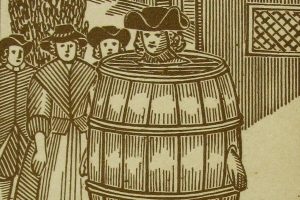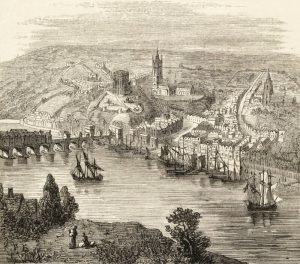Breaking News: The Chilling Tale of the “Death Cloak” That Haunted Drunkards More Than a Bad Hangover!

If you’ve ever had the unfortunate experience of waking up with a pounding headache, upset stomach, grave nausea, and a flood of regrets after a long night of drinking, then congratulationsyou’ve experienced a hangover. For most, this painful morning-after ordeal might seem like a sufficient deterrent against excessive drinking. However, for people in 16th-century England, the stakes were even higher. They devised a far more humiliating punishment for repeat offenders: the Drunken Cloak.
The mechanics of this absurd punishment were quite straightforward. Anyone found guilty of repeated offenses of drunkenness would be compelled to don a hollowed-out beer barrel, with an opening at the top for their head and two side holes for their armsassuming they were somewhat fortunate. They would then be paraded through the town, subjecting them to the judgmental stares and jeers of their neighbors.
Alcohol culture has long been a part of Englands historical narrative, but the Drunken Cloak also represented a notable resistance to this ingrained cultural practice, serving as a reflection of society’s attempts to curtail misbehavior. The use of the cloak in public spaces delineated a stark contrast between acceptable social norms and the scandalous actions of individuals who drank too much.
The significance of drinking culture in northeastern England is particularly intriguing when discussing the origins of the Drunken Cloak, which is also colloquially known as the Newcastle Cloak. Historians speculate that it may have been first utilized to punish drunkards in the city of Newcastle upon Tyne, located in the northeast of England. The details surrounding the precise inception of this punitive measure are somewhat ambiguous. While it is acknowledged that the cloak was used in various cities across Europe, the specific birthplace of this concept remains uncertain. As tour guide Alex Lyon from the Clink Prison Museum in London commented to Newcastle World, “While we only have concrete evidence of its use in Newcastle upon Tyne in the 1650s, during the Puritan regime, we dont want to imply it was invented there.”

“It’s a bit of a cliché, but the drinking culture is deeply entrenched here,” Jackson noted. Newcastle likes to claim it was among the first cities in England to brew beer. The hospitality associated with Newcastle was a well-known expression in the 18th centuryessentially meaning to lavish someone with kindness (often through encouraging them to indulge in a long night of drinking).
In truth, the residents of Newcastle have turned to alcohol for centuries for many of the same reasons as modern-day locals: a need to unwind after a grueling day. In the past, such days often involved backbreaking labor in coal mines or shipyards rather than sitting in an office cubicle for eight hours.
“It was inevitable that drinking would happen when people had a break from that stressful work,” Jackson explains. The coal miners, in particular, were notorious for their drinking habits, and so were shipyard workers and sailors who could be away from home for months, returning with money to spare and a desire to celebrate.
Naturally, when large groups of stressed individuals start drinking excessively, its not long before some mistakenly cross the line into drunkenness. This excessive drinking spurred local authorities to take action against the rampant behavior.
The Parliament sought to curb alcohol consumption, leading to the creation of the Drunken Cloak. Concerned about the negative repercussions of unabated drunkenness, Parliament began looking for regulatory solutions for alcohol consumption throughout England. As a preliminary measure, they passed the 1551 Brewery Act, which officially categorized drunkenness as a civil offense.

As reported by VinePair, any individual found guilty of public intoxication faced a small fine of five shillings. However, additional arrests for public drunkenness resulted in far stricter and more humiliating penaltiesspecifically, the Drunken Cloak.
The cloak was essentially an open beer barrel with a head holesometimes featuring arm openings, though that was not guaranteed. According to “The Great Book of Pain: Torture and Punishment Through History” by Mark P. Donnelly and Daniel Diehl, the concept of the Drunken Cloak may have emerged during the reign of King James I of England. Allegedly, the king had a penchant for creating bizarre punishments that were singularly tailored to match the nature of the crime committed.
The use of the Drunken Cloak gained traction, however, under the rule of Oliver Cromwell, a soldier and political leader who served as Lord Protector of England, Scotland, and Ireland from 1653 to 1658. According to Ancient Origins, Cromwell had a distaste for games, dancing, and especially drinking.
Whats even more fascinating is how the Drunken Cloak quickly spread beyond the borders of England. In Germany, it was known as Schandmantel, the cloak of shame, while in Denmark, the punishment took on the title of Spanish Cloak. As one might expect, this peculiar form of public humiliation eventually made its way across the ocean to America.

Though originating in Europe, the Drunken Cloak found its way to the United States during the 19th century. According to “Curious Punishments of Bygone Days” by Alice Morse Earle, it was occasionally employed to punish soldiers during the Civil War. A sad delinquent was, as described, “framed with oak, with his head stuffed through a hole cut into one end of the barrel,” leading to the unfortunate fellow staggering about in the most disconsolate manner, resembling a dazed chicken.
Earle also uncovered other instances of the Drunken Cloak’s use, including an incident in 1863 when a lieutenant from a volunteer infantry unit in Maine punished two of his company members who had become intoxicated by placing them inside barrels with only head holes for their escape. He marched them through the town with a sign that read, “Im wearing this for being drunk for four hours.”
The lieutenant quipped, “I dont believe theyll be getting drunk again anytime soon.” One officer even claimed that years later, one of his men thanked him for the punishment, expressing that after experiencing the Doctor’s Cloak, he never touched a drop of alcohol again.
Soldiers during the Civil War could also find themselves forced into the Drunken Cloak for theft. Earle documented cases where men had to don a barrel, bearing a sign that declared, “I am a thief.” What stands out most about the Drunken Cloak is its effectiveness despite being relatively harmless. In comparison to harsher methods of punishment or torture, the Drunken Cloak was distinctly more humane, relying more on the power of public scrutiny rather than inflicting physical pain. It was often successful in changing individuals’ behavior.
However, the Drunken Cloak eventually faded from societal norms. Despite this, drinking remains a popular pastime in areas like Newcastle. “Alcohol has always played a significant role in the culture of Northumbria, for better or for worse,” historian Dan Jackson concluded. “It has always been a kind of social lubricant, and Newcastle continues to be recognized as a party city today. This tradition dates back centuries, making it challenging to break away from this cultural legacy.”
Leave a Reply